Instrumental Classroom Music (Grades K–12)
Subtest 2 Sample Items
Recommendation for individuals using a screenreader: please set your punctuation settings to "most."
Expand All | Collapse All
Question 1
1. Use the example below to answer the question that follows.

Which of the following key signatures is shown in this example?
- D-flat major
- E-flat minor
- G-flat major
- A-flat minor
Answer to question 1
- Answer Enter to expand or collapse answer. Answer expanded
- Correct Response: A. (Objective 0008) The example presents five flats. In every clef, the order of flats in a key signature remains the same: B-E-A-D-G-C-F. One way to determine the key signature of a major scale with flats is to identify the second-to-last flat. The name of the second-to-last flat is the name of the key signature, thus D-flat major.
Question 2
2. Use the example below to answer the question that follows.

Which of the following pitch names best describes the note shown above?
- C-sharp
- D-sharp
- E-sharp
- F-sharp
Answer to question 2
- Answer Enter to expand or collapse answer. Answer expanded
- Correct Response: A. (Objective 0008) The clef shown in the example is a tenor clef, which establishes the fourth line of the staff as middle C. The note in the example is one octave higher than the fourth line of the staff, so with the addition of a sharp symbol, it would be identified as C-sharp.
Question 3
3. Which of the following ranges of metronome markings best indicates the most appropriate tempo when the term andante is printed in the music?
- M.M. = 40– to 60
- M.M. = 80– to 100
- M.M. = 100– to 120
- M.M. = 120– to 140
Answer to question 3
- Answer Enter to expand or collapse answer. Answer expanded
- Correct Response: B. (Objective 0008) Metronome markings associated with Italian tempi vary from source to source and are usually given as a range of beats per minute rather than as one specific marking. The style, complexity, and performance medium of the composition also affect the choice of tempo. The term andante usually indicates a moderate walking tempo. Andante is faster than adagio and slower than allegro. The metronome marking range of 80–100 is the only one that could reasonably fit these descriptions.
Question 4
4. Which of the following time signatures suggests a combination of duple and triple meters?
 3 8
3 8 5 4
5 4 6 8
6 8 9 4
9 4
Answer to question 4
- Answer Enter to expand or collapse answer. Answer expanded
- Correct Response: B. (Objective 0008) Duple meter indicates two beats per measure and triple meter indicates three beats per measure. The time signature in the correct response can be grouped either two plus three or three plus two, namely 1 2 1 2 3 or 1 2 3 1 2, respectively.
Question 5
5. A music teacher is entering the following passage into notation software using the tuplet tool.

In measure one, beat one is a quarter note, beat two is a quintuplet, beat three is a quarter note, and beat four is a quintuplet. Measure two is four eighth notes, a quarter notes, and a quarter rest.
The quintuplet above is equivalent to which of the following rhythmic durations?
- six thirty-second notes
- four sixteenth notes
- eight sixty-fourth notes
- two eighth-note triplets
Answer to question 5
- Answer Enter to expand or collapse answer. Answer expanded
- Correct Response: B. (Objective 0008) In this example, the five notes of a sixteenth-note quintuplet take place in one beat. In a simple meter like common time shown above, one beat contains the equivalent of two eighth notes, four sixteenth notes, eight thirty-second notes, or sixteen sixty-fourth notes.
Question 6
6. Which of the following chord progressions is a plagal cadence?
-
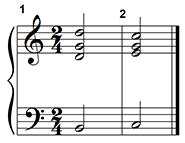
-
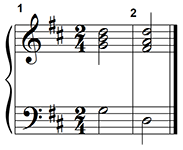
-
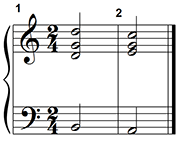
-
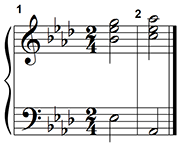
Answer to question 6
- Answer Enter to expand or collapse answer. Answer expanded
- Correct Response: B. (Objective 0009) A plagal cadence features
the chord progression IV-I. The only response option in which a subdominant chord moves to a tonic chord
is option B.
Question 7
7. Use the example below to answer the question that follows.

Which of the following rhythms represents the most appropriate realization of the Baroque appoggiatura shown in the example?
-

-

-

-

Answer to question 7
- Answer Enter to expand or collapse answer. Answer expanded
- Correct Response: C. (Objective 0009) Johann Sebastian Bach's system for realizing Baroque ornaments is the most commonly used system today. In the Little Clavier Book for Wilhelm Friedemann Bach, Bach constructed a table that codified important ornaments used in the Baroque era. The example illustrates a long appoggiatura, which is performed on the beat. It usually takes half the time of the note that follows it, except when it is followed by a dotted note, when it takes two-thirds of the value of the main note.
Question 8
8. Use the example below to answer the question that follows.
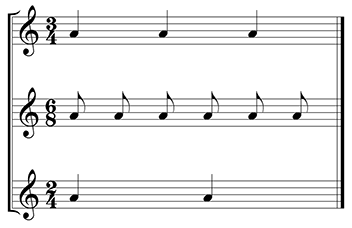
Which of the following rhythmic terms best describes the example?
- hemiola
- polymeter
- polyrhythm
- syncopation
Answer to question 8
- Answer Enter to expand or collapse answer. Answer expanded
- Correct Response: B. (Objective 0009) The term polymeter,
or polymetric, describes musical passages or compositions that appear to contain more than one meter simultaneously,
as is the case in the example.
Question 9
9. Use the example below to answer the question that follows.
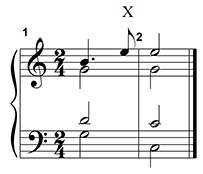
Two-four meter. Two measures. Measure one. Treble clef. Two notes played simultaneously, half note on G and dotted quarter note on B. Eighth note on E with an X on top. Bass clef. Two half notes played simultaneously, G and the D just above middle C. Measure two. Treble clef. Two half notes played simultaneously, G and E. Bass clef. Two half notes played simultaneously, C and middle C.
Which of the following nonchord tones is illustrated by the eighth note in the example?
- anticipation
- appoggiatura
- changing tone
- escape tone
Answer to question 9
- Answer Enter to expand or collapse answer. Answer expanded
- Correct Response: A. (Objective 0009) The anticipation is
a nonchord tone that is approached by step or leap, and it becomes a chord tone with a subsequent change
in harmony. It is unaccented and usually occurs in the soprano, or top voice.
Question 10
10. Use the excerpt below to answer the question that follows.

Which of the following terms best describes the rhythmic pattern shown above?
- habanera
- Scotch snap
- krakowiak
- tarantella
Answer to question 10
- Answer Enter to expand or collapse answer. Answer expanded
- Correct Response: A. (Objective 0009) The rhythmic pattern shown above is most closely associated with the habanera, which is an Afro-Cuban dance and song with moderate to slow tempo. A famous example occurs in George Bizet's opera Carmen.
Question 11
11. Use the excerpt below to answer the question that follows.

Which of the following chromatic chords best describes the sonority at the end of measure 2?
- German augmented sixth
- Neapolitan sixth
- French augmented sixth
- Italian augmented sixth
Answer to question 11
- Answer Enter to expand or collapse answer. Answer expanded
- Correct Response: D. (Objective 0009) Augmented-sixth chords are chromatic harmonies that contain an augmented-sixth interval, which is one half-step larger than a major sixth. Augmented-sixth chords are most often built upon the lowered scale degree six in the bass. This bass note forms an augmented-sixth interval against a raised scale degree four. For example, in C major this would be an A-flat in the bass with an F-sharp above it. In addition to these two pitches, all three nationality-named chords also contain scale degree one. The Italian augmented sixth is unique for having only these three different pitches while the French has an additional scale degree two and the German a lowered scale degree three.
Question 12
12. Use the example below to answer the question that follows.
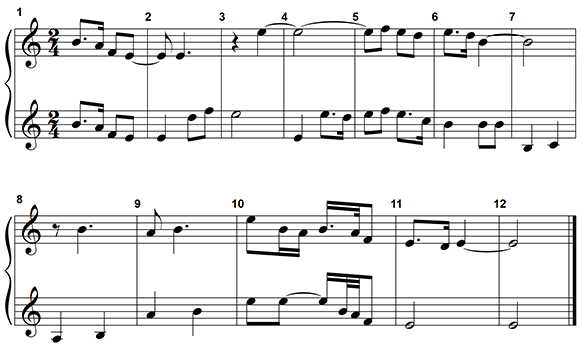
Two staves connected with a bracket, both in treble clef and using two-four time. Twelve measures. Measure one. Top treble clef. Dotted eighth note on B and sixteenth note on A followed by two eighth notes, F and E with a tie. Bottom treble clef. Dotted eighth note on B and sixteenth note on A followed by two eighth notes, F and E. Measure two. Top treble clef. Tied eighth note on E followed by a dotted quarter note on E. Bottom treble clef. Quarter note on E followed by two eighth notes, D and F. Measure three. Top treble clef. Quarter rest followed by quarter note E with a tie. Bottom treble clef. E quarter note followed by a dotted eighth note on E and a sixteenth note on D. The rest of the excerpt continues in this manner in which one melody seems to paraphrase and slightly vary the other melody.
Which of the following terms best describe the relationship of the two melodic lines in the example?
- figuration
- heterophony
- imitation
- polyphony
Answer to question 12
- Answer Enter to expand or collapse answer. Answer expanded
- Correct Response: B. (Objective 0010) In the example, essentially
the same melody, with modifications, is present in both melodic lines. The simultaneous use of slightly
or elaborately modified versions of the same melody by two (or more) performers is called heterophony.
Question 13
13. Which of the following schematic designations best describes bar form?
- ABA
- AAB
- AABA
- ABAB
Answer to question 13
- Answer Enter to expand or collapse answer. Answer expanded
- Correct Response: B. (Objective 0010) Bar form was an old, very important musical form in choral music in western Europe. The name is derived from the medieval German term bar, which was a poem in which each stanza was divided into two similar sections (AA) and a different third section (B), making the designation AAB. Troubadours and trouvères in the twelfth and thirteenth centuries and minnesingers and Meistersingers in the twelfth through fifteenth centuries used this scheme for many of their lyrical songs. It was equally common in the German polyphonic songs of the fifteenth and sixteenth centuries, and later in the chorales of the German Protestant Church, including the various compositions based on them.
Question 14
14. A junior high school music appreciation teacher would like students to enjoy listening to classical music. To best achieve this goal, the music teacher should most likely play recordings of compositions with which of the following musical criteria?
- microtonal scales
- piano dynamics
- syncopated rhythms
- 12-tone serialism
Answer to question 14
- Answer Enter to expand or collapse answer. Answer expanded
- Correct Response: C. (Objective 0010) Most listeners, especially adolescents, are not likely to find aesthetic pleasure in unfamiliar microtonal scales or the dissonant harmonies and disjunct melodies of 12-tone serialism. Music with piano dynamics may create a soothing sleep-inducing effect. Adolescents encounter syncopation in their preferred genres of choice. Playing syncopated classical music can help bridge the gap between familiar pop favorites and unfamiliar classical music.
Question 15
15. Use the excerpt below to answer the question that follows.

Which of the following pitches correctly completes the 12-tone row shown above?
- F-natural
- D-flat
- G-sharp
- B-flat
Answer to question 15
- Answer Enter to expand or collapse answer. Answer expanded
- Correct Response: D. (Objective 0010) In 12-tone serialism,
a tone row melody must present all 12 notes, or pitch classes, of the chromatic scale once before a
note can be repeated. The tone row assumes enharmonic equivalency, meaning that C-sharp equals D-flat,
E-sharp equals F-natural, etc. The only pitch class missing from the tone row above is B-flat.
Question 16
16. Which of the following composers is most likely to have written a parody Mass based on a secular song?
- Hildegard von Bingen
- Guillaume Dufay
- Tomás Luis de Victoria
- Antonio Vivaldi
Answer to question 16
- Answer Enter to expand or collapse answer. Answer expanded
- Correct Response: B. (Objective 0011) The practice of using a secular song rather than a plainchant melody as the basis for a setting of the Mass became common in continental Europe by the mid-fifteenth century. This technique was used by many Renaissance composers, including Guillaume Dufay. His Missa Se la face ay pale is among the best-known examples of a parody Mass, which is based on his popular secular chanson (song) “Se La Face Ay Pale” (If my face is pale).
Question 17
17. Which of the following fourteenth-century composers is best known for a style of medieval poetry and music with the designation formes fixes?
- Jacopo da Bologna
- Francesco Landini
- Guillaume de Machaut
- John Dunstaple
Answer to question 17
- Answer Enter to expand or collapse answer. Answer expanded
- Correct Response: C. (Objective 0011) Formes fixes
is a collective designation for three important forms of medieval poetry and music—ballade, virelai,
and rondeau—which were polyphonic pieces containing three parts. The top part was for voice and
the other two parts were for instruments (tenor and contratenor). Guillaume de Machaut played a very
significant role in the development of these compositions as the formes fixes of French poetry
and music in the fourteenth century.
Question 18
18. Use the excerpt below to answer the question that follows.
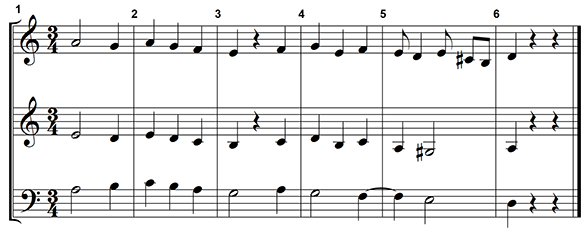
All three staves are connected with a bracket, consist of six measures, and are in three four time. Measure one. Top treble clef. Half note on A. Quarter note on G. Bottom treble clef. Half note on E. Quarter note on the D just above middle C. Bass clef. Half note on A. Quarter note on the B just below middle C. Measure two. Top treble clef. Three descending quarter notes A-G-F. Bottom treble clef. Three descending quarter notes E-D-C. Bass clef. Three descending quarter notes C-B-A. This series of first inversion triads ends on the downbeat of measure three with G in the bass, B in the tenor above it, and E in the soprano.
Which of the following terms associated with the late Middle Ages and early Renaissance is most clearly illustrated in the example?
- clausula
- conductus
- fauxbourdon
- rondel
Answer to question 18
- Answer Enter to expand or collapse answer. Answer expanded
- Correct Response: C. (Objective 0011) Fauxbourdon is a term applied to a fifteenth-century practice in Western music in which the two outer voices were notated. The upper voice sang the plainsong while the lower voice moved in parallel sixths below, or occasionally at the octave. The middle voice improvised a perfect fourth below the plainsong, as is the case in the example. Fauxbourdon resembles a series of first-inversion triads.
Question 19
19. Which of the following statements best describes Johann Sebastian Bach's impact on the history of
Western music?
- Bach was the first composer to write four-part string and woodwind quartets.
- Bach's operas synthesize established traditions associated with Italian and French styles.
- Bach led the development of musical nationalism through tone poems and mazurkas.
- Bach's chorales are microcosms of functional tonality and textbook dissonance treatment.
Answer to question 19
- Answer Enter to expand or collapse answer. Answer expanded
- Correct Response: D. (Objective 0011) For centuries, musicians
have studied J.S. Bach's 371 chorales to better understand harmonic progressions, voice leading, and
ways of preparing and resolving dissonances. Of the genres listed above, the only one in which Bach
composed is chorale.
Question 20
20. Which of the following female composers is renowned for being a nun, having prophetic visions, writing
about science and medicine, and composing the Medieval morality play Ordo Virtutum?
- Barbara Strozzi
- Hildegard von Bingen
- Francesca Caccini
- Comtessa de Dia
Answer to question 20
- Answer Enter to expand or collapse answer. Answer expanded
- Correct Response: B. (Objective 0011) Hildegard von Bingen (1098– to 1179) was a Medieval composer, scientist, and nun who later became a saint. Perhaps her best-known musical work is Ordo Virtutum, which is the first Medieval morality play. The monophonic textures, parallel perfect intervals, and plainchant are characteristic of Medieval music.
Question 21
21. Which of the following descriptions best characterizes Johannes Brahms’s contributions to the development of Western music?
- experimenting with the innovative use of leitmotifs in his German operas
- enriching the woodwind and French horn repertoires through his concertos
- extending the inherited First Viennese School tradition with his symphonies
- expressing the nationalist sentiment of his fellow Czechs in his tone poems
Answer to question 21
- Answer Enter to expand or collapse answer. Answer expanded
- Correct Response: C. (Objective 0012) Johannes Brahms (1833– to 97) continued writing absolute music using traditional forms and genres established by the First Viennese composers (Haydn, Mozart, and Beethoven) while others were writing program music in new genres. Brahms never wrote an opera, a concerto for a wind instrument, or a tone poem. Response options A, B, and D describe Richard Wagner, Wolfgang Amadeus Mozart, and Bedřich Smetana, respectively.
Question 22
22. Which of the following genres of Western music was first popularized during the Classical period?
- concerto
- sonata
- string quartet
- tone poem
Answer to question 22
- Answer Enter to expand or collapse answer. Answer expanded
- Correct Response: C. (Objective 0012) Franz Joseph Haydn
has been called the father of the string quartet. In the 1760s and 1770s, he began to compose music
for four string instruments. He replaced the old Baroque basso continuo with a single cello, and he
added a viola immediately above the cello, creating a texture covered more or less equally by two violins,
a viola, and a cello.
Question 23
23. Which of the following nineteenth-century composers wrote many stylized versions of Polish dances
for piano?
- Frédéric Chopin
- Louis Moreau Gottschalk
- Clara Wieck Schumann
- Fanny Hensel
Answer to question 23
- Answer Enter to expand or collapse answer. Answer expanded
- Correct Response: A. (Objective 0012) Frédéric
Chopin (1810– to 1849), the son of a French father and a Polish mother, was born with the name Fryderyk in Poland and spent the first half of his life in Warsaw. Later he moved to Paris and made his living teaching, composing, and performing on the piano. He wrote many stylized polonaises and mazurkas, originally Polish dance forms, for the piano as an expression of his intense national pride for his oppressed native land. This music is also an example of the musical nationalism that was prevalent in the nineteenth century.
Question 24
24. Which of the following trios of composers best exemplifies the style holy minimalism?
- Henryk Górecki, Arvo Pärt, John Tavener
- Witold Lutosławski, Krzysztof Penderecki, Kazimierz Serocki
- Claude Debussy, Maurice Ravel, Erik Satie
- Alban Berg, Arnold Schoenberg, Anton Webern
Answer to question 24
- Answer Enter to expand or collapse answer. Answer expanded
- Correct Response: A. (Objective 0012) The term holy minimalism describes a late twentieth- and early twenty-first-century musical style in which primarily European composers set sacred (holy) texts using limited musical materials and ample repetition (minimalism). The composers in response options B, C, and D all share a particular style and nationality, namely sound mass and Poland, impressionism and France, and 12-tone serialism and Austria, respectively. The only trio of composers above who all wrote holy minimalism are the Polish Henryk Górecki (1933– to 2010), Estonian Arvo Pärt (1935– dash), and British John Tavener (1944– to 2013).
Question 25
25. Which of the following accomplishments best describes Franz Schubert's role in Western music history?
- inventing the string quartet genre
- reviving an interest in J.S. Bach's vocal music
- popularizing Polish folk dances
- contributing to the development of the lied
Answer to question 25
- Answer Enter to expand or collapse answer. Answer expanded
- Correct Response: D. (Objective 0012) The six hundred art
songs, or lieder, by Franz Schubert (1797–1828) contain remarkable chromatic innovations and exemplary
musical expressions of the text. While the other options describe the musical contributions of Franz
Joseph Haydn, Felix Mendelssohn, and Frédéric Chopin, respectively, Schubert is best remembered for developing the German lied, which is also called an art song.
Question 26
26. Traditional Hmong music is most likely to feature which of the following instruments?
- brass cymbals
- clay harmonica
- bamboo flute
- goat bagipe
Answer to question 26
- Answer Enter to expand or collapse answer. Answer expanded
- Correct Response: C. (Objective 0013) The Hmong are an ethnic people from Southeast Asia. The communist takeover of Laos and Vietnam in the 1970s forced many Hmong refugees to immigrate, some choosing Minnesota. Traditional Hmong music is often played on a bamboo flute. Several bamboo tubes can be assembled to form a type of reed-pipe mouth organ called the qeej, which is an iconic Hmong instrument.
Question 27
27. Which of the following instruments is the most frequently used type of drums in the traditional Hindustani music of Northern India?
- sitar
- xylophone
- tabla
- tanpura
Answer to question 27
- Answer Enter to expand or collapse answer. Answer expanded
- Correct Response: C. (Objective 0013) Tabla, which are the
most common drums for traditional Hindustani music, are paired drums with individual heads that are
played with the hands. The treble drum is called dahina, meaning "right," and the bass drum
is called baya, meaning "left."
Question 28
28. Which of the following performers is most closely associated with the trumpet?
- Benny Goodman
- Charlie Parker
- John Coltrane
- Miles Davis
Answer to question 28
- Answer Enter to expand or collapse answer. Answer expanded
- Correct Response: D. (Objective 0013) Miles Davis (1926– to 91) is widely considered to be one of the most influential trumpet players in jazz history. He influenced the development of bebop, cool jazz, and fusion. The other performers are associated with the clarinet, alto saxophone, and tenor saxophone, respectively.
Question 29
29. In Mariachi music, the guitarrón is primarily responsible for which of the following musical functions?
- playing the melody
- producing a polyphonic texture
- providing the bass
- presenting countermelodies
Answer to question 29
- Answer Enter to expand or collapse answer. Answer expanded
- Correct Response: C. (Objective 0013) Mariachi is a well-known
style of music associated with Mexico. Mariachi bands have trumpets, violins, a small guitar called
a vihuela, and a big acoustic bass guitar called a guitarrón. The guitarrón plays the
bass notes of chords and helps keep the ensemble together.
Question 30
30. Ella Fitzgerald and Billie Holiday most strongly cultivated which of the following musical styles?
- rock
- opera
- jazz
- folk
Answer to question 30
- Answer Enter to expand or collapse answer. Answer expanded
- Correct Response: C. (Objective 0013) Ella Fitzgerald (1917–1996)
and Billie Holiday (1915–1959) both sang jazz but developed it in different ways. For example,
Ella Fitzgerald is best remembered for a type of jazz singing called scat while Billie Holiday's expressive
recordings of jazz standards reflect her troubled life.
Question 31
31. Use the excerpt below to answer the question that follows.
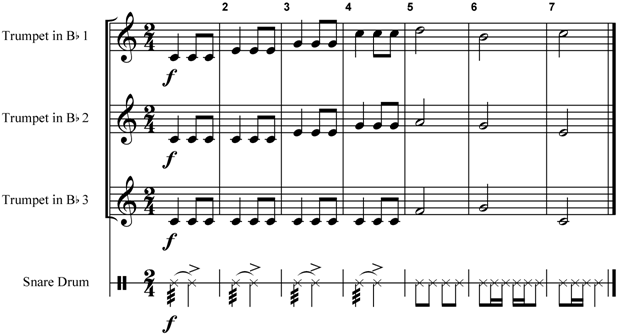
Which of the following rudiments best describes the snare drum part in measures 1– to 4 of this excerpt?
- five-stroke roll
- nine-stroke roll
- thirteen-stroke roll
- seventeen-stroke roll
Answer to question 31
- Answer Enter to expand or collapse answer. Answer expanded
- Correct Response: B. (Objective 0014) To determine the number of strokes in a roll, identify the number of thirty-second notes in the rolled note and add one. The length of one quarter note equals eight thirty-second notes. Eight plus one is nine; thus, a quarter-note roll is another term for a nine-stroke roll.
Question 32
32. Which of the following reasons is the most likely cause of a beginning string player's tendency to make "squeaky" sounds on some notes?
- The speed of the player's bow is too slow.
- The fingers on the player's right hand are placed incorrectly on the frog and bow stick.
- The hair of the player's bow is too tight
- The fingers on the player's left hand do not press the string firmly on the fingerboard.
Answer to question 32
- Answer Enter to expand or collapse answer. Answer expanded
- Correct Response: D. (Objective 0014) Beside learning how to hold, balance, and guide the bow with the right hand and arm, another challenge for beginning string players is the left-hand fingering technique. At its most fundamental, this involves learning to always press the string firmly with the fingertips so the string is fully in contact with the fingerboard for each stopped note. This, in combination with a correctly drawn bow stroke, produces a clear, vibrant tone. If the string isn't depressed fully, the resulting sound will more likely be a squeak than an actual pitch. For beginning string players who are just getting used to using their left hand in an unusual way and whose fingers usually need time to develop more strength, this is a common cause of occasional squeaks.
Question 33
33. Which of the following actions should most improve the health of high school ensemble musicians?
- instructing brass players to purchase a mouthpiece with a shallower cup
- directing woodwind players to place their instruments on their laps during rests
- asking low string players to utilize mutes during rehearsals
- requiring unpitched percussionists to use a practice pad during rehearsals
Answer to question 33
- Answer Enter to expand or collapse answer. Answer expanded
- Correct Response: D. (Objective 0014) A snare drum can produce extremely high decibel levels that could cause hearing damage. A practice pad makes a much quieter sound than a snare drum. A deeper, not shallower, cup might help some trumpet players who wear braces. Placing a woodwind across one's lap will not improve health because holding those instruments is not harmful. Wearing earplugs would be more beneficial for the ears than using a mute.
Question 34
34. A high school band director is studying a potential score but the school does not own a marimba, which has a prominent part. Which of the following instruments and mallets would best serve as an acceptable substitute to cover these parts?
- a glockenspiel, using soft rubber mallets on the lower octaves of the instrument
- a set of orchestra bells, using soft rubber mallets on the lower octaves of the instrument
- a vibraphone, using soft rubber or yarn-covered mallets on the lower octaves of the instrument
- a xylophone, using soft rubber or yarn-covered mallets on the lower octaves of the instrument
Answer to question 34
- Answer Enter to expand or collapse answer. Answer expanded
- Correct Response: D. (Objective 0014) Xylophones and marimbas are potential substitutes for each other, provided the appropriate kinds of mallets are used. Both instruments have wooden bars, but marimba bars are wider and flatter, which produces a mellower tone quality than the xylophone. In making a xylophone serve as a marimba, soft rubber or yarn-covered mallets should be used, and the parts should be played on the lower octaves of the instrument.
Question 35
35. A beginning elementary clarinetist is having difficulty producing the correct pitches, often creating loud squeaks. After determining that the reed is undamaged and properly aligned, the instructor should next check for which of the following student-centered causes?
- covering a tone hole incompletely with one of the fingers
- inserting not enough of the mouthpiece in the mouth
- holding the instrument at too high of an angle with the hands
- placing too much of the lower lip over the teeth.
Answer to question 35
- Answer Enter to expand or collapse answer. Answer expanded
- Correct Response: A. (Objective 0014) Elementary school beginners usually have smaller fingers than older students, so it is often more difficult for them to cover the tone holes completely. This allows air to escape around the fingers, producing a squeal or squeak rather than the correct pitch. Although there are other possible causes of the squeaks, this one is very common and should be checked by the instructor when working with a beginner.
Question 36
36. A beginning trumpet player asks the music teacher how to finger the following note.

The music teacher responds, "I will not tell you the fingering because you can figure it out on your
own with the following hint. That pitch is four half-steps below an overtone." Which of the following
fingerings is most appropriate?
-

-

-

-

Answer to question 36
- Answer Enter to expand or collapse answer. Answer expanded
- Correct Response: C. (Objective 0014) On a valved brass instrument like a trumpet, the same combination of valves can produce different pitches. For example, playing a note "open," which means playing while pressing down zero valves, produces a series of natural overtones C4 (one ledger line below the staff using a treble clef), G4, C5, E5, G5, and beyond. Pressing down the middle valve produces a pitch that is one half-step (minor second) below each of those overtones. Pressing down the first valve with the index finger lowers the overtone by two half-steps (major second). Pressing down the first and second valves together lowers an open note by three half-steps (minor third). Pressing down the second and third valves together lowers a note by four half-steps (major third).
Question 37
37. Which of the following statements is most often true of a vocal jazz arrangement that uses wind
instruments as part of the accompaniment?
- The arrangement includes three horns, often in three-note voicings containing the third and seventh
of the chord but no root.
- The arrangement uses wind instruments playing repetitive figures throughout to contribute to the hypnotic
drive of the music.
- The arrangement includes an instrumental quartet of the same family, mostly doubling the voice parts
and providing interludes.
- The arrangement uses mostly horn unisons and simple triads for strength and simplicity in providing
energy to the accompaniment.
Answer to question 37
- Answer Enter to expand or collapse answer. Answer expanded
- Correct Response: A. (Objective 0015) Wind instruments are
increasingly being included, along with a rhythm section, in accompaniments for vocal jazz choirs. Most
published jazz arrangements that include winds call for three horns: high, medium, and low. In a jazz
setting, a mixture of unison, open, and close voicings is used, and most three-note voicings include
the third and seventh of the chord but not the root to avoid a bottom-heavy sonority.
Question 38
38. Which of the following statements best explains the relationship between a performer and a composer's intentions?
- Performers should strive to play from a professionally edited edition of a composer's autograph manuscript.
- Performers should try to compose a 12-tone cadenza for a First Viennese School composer's concerto.
- Performers should attempt to follow a composer's written musical instructions as closely as possible.
- Performers should seek to play a composer's earliest and latest compositions to learn different styles.
Answer to question 38
- Answer Enter to expand or collapse answer. Answer expanded
- Correct Response: C. (Objective 0015) Composers express their musical intentions as precisely as they can through notation. Musicians must aim to perform precisely what the composer wrote. For example, if the composer wrote a whole note in common time, then the performer should hold it for four full beats and release on the following downbeat. Regarding the first response option, a heavily edited version of a composition reflects the editor's musical choices, not the composer's exclusively. Regarding the second response option, it is not musically appropriate to perform a dodecaphonic cadenza in a concerto by Beethoven or Mozart because the incongruity of the two musical styles would produce a jarring aesthetic effect that was never intended by the composer. Regarding the last response option, although playing a composer's first and last compositions might lead to deeper insights about that particular composer's compositional language, composers do not intend or require performers to do so.
Question 39
39. Which of the following reasons best justifies the incorporation of orchestral transcriptions into the repertoire of an accomplished high school band or wind ensemble?
- Performing music in more difficult keys and with more frequent modulations will help band students
play with better intonation.
- Presenting a greater variety of art music in school concerts will help the audience and administration
come to appreciate it more.
- Rehearsing, listening to, and comparing music from various genres and historical periods should be
part of music education for wind players.
- Broadening wind players' exposure to a more varied repertoire will improve their ability to sight-read
and interpret different articulation markings.
Answer to question 39
- Answer Enter to expand or collapse answer. Answer expanded
- Correct Response: C. (Objective 0015) Ideally, band directors should select music that will challenge and improve performance skills as well as provide opportunities to teach aspects of form, music theory, and music history. Rehearsing, listening to, and comparing music from various genres and historical periods is a valuable component of the musical education of performers. Since orchestras are older than the modern wind band, they have a broader range of high-quality literature from various historical periods and genres. Incorporating orchestral transcriptions into the band or wind ensemble repertoire will help accomplish this educational goal.
Question 40
40. Most band music by Anne McGinty is most appropriate for which of the following ensembles?
- elementary school beginning band
- high school concert band
- junior high school marching band
- middle school jazz band
Answer to question 40
- Answer Enter to expand or collapse answer. Answer expanded
- Correct Response: A. (Objective 0015) Anne McGinty is an important pedagogically minded composer-arranger. She has written dozens of concert band compositions and arrangements, most with a difficulty level of very easy or easy, which makes them appropriate for students in their first or second years of instruction.